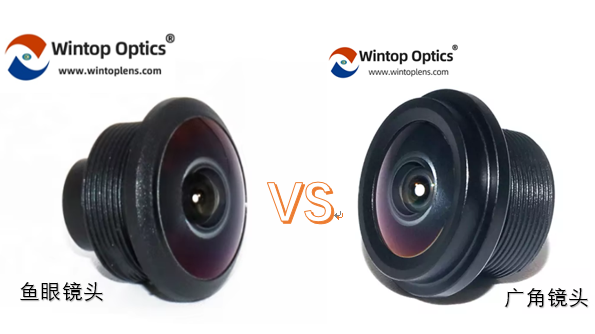
A wide-angle camera lens is a photographic lens with a focal length shorter than a standard lens, a viewing angle larger than a standard lens, a focal length longer than a fisheye lens, and a viewing angle smaller than a fisheye lens.
A fisheye camera lens is a lens with a focal length of 16mm or less and a viewing angle close to or equal to 180 °. It is an extreme wide-angle lens, and "fisheye lens" is its common name.
The difference between the two:
- Field of view: Fisheye lenses have a very wide field of view, usually more than 180 degrees, and can capture a very wide scene, or even show a fisheye effect, that is, the center of the image is stretched and the edges are curved. The field of view of wide-angle lenses is usually between 90 degrees and 120 degrees, and the captured scene is wider, but not as wide as fisheye lenses.
- Perspective effect: The lens design and field of view of the fisheye lens are special, and the captured image will produce a curved perspective effect, making the object in the center of the image appear larger, and the object at the edge will be stretched to create a unique effect. The wide-angle lens can also capture a wide scene, but generally there will be no curved perspective effect.
- Distortion effect: The fisheye lens has a very obvious distortion effect, the image shows a curved shape, the center part is relatively normal, but the edge part will be stretched and distorted. The distortion effect of the wide-angle lens is relatively small, and the shape of the image is closer to reality.
- Focal length selection: Fisheye lenses usually have a very short focal length, often between 8mm and 16mm, which allows them to capture very wide scenes. The focal length of wide-angle lenses is relatively longer, generally between 20mm and 35mm, and some lenses even exceed 50mm.
- Application examples of wide-angle lenses:
- Landscape photography: A wide-angle lens can capture vast scenes such as vast skies, beautiful mountains, and magnificent beaches. It can help photographers incorporate more elements into the picture to create a broad landscape effect.
- Architectural photography: Wide-angle lenses can capture the general outline and texture of a building, making it look grander and larger. It allows photographers to capture entire buildings in tight spaces, such as cathedrals, skyscrapers or narrow streets.
- Interior photography: In indoor environments, wide-angle lenses can capture more details, making them suitable for photographing interior design, museums, galleries, and other indoor venues. They can bring out the atmosphere and layout of the entire space.
- Vehicle cameras: They are usually installed in the front and rear parts of the car to increase the driver's field of view and improve safety. It can be turned into rear monitoring camera lenses, car reversing aid camera lenses, fatigue monitoring camera lenses, blind spot detection lenses, driving recorder camera lenses, driver security cameras lenses.
- Smart home: Wide-angle lens can be used for smart home security camera lens. Perform environmental awareness, real-time positioning and tracking, and enhance virtual reality experience.
b.Application examples of fisheye lenses:
- Photography and filmmaking: Fisheye lenses are often used in photography and filmmaking to capture a very wide range of scenery or scenes. They are widely used in sports events, travel documentaries, outdoor sports dv camera lenses and other fields to present unique and exaggerated visual effects.
- CCTV cameras: Fisheye lenses play an important role in traffic monitoring systems. Installed in areas such as intersections, parking lots or prisons, it can provide a full range of monitoring views, thus enhancing security and surveillance effects.
- Astronomy: Astronomers use fisheye lenses to observe the sky, especially for capturing images of the stars throughout the sky. These camera lenses capture a wide view of the sky and are useful for studying celestial bodies such as galaxies, planets, and nebulae.
- Scientific research and industrial applications: Fisheye lenses also play an important role in scientific research and industrial applications. For example, they are used in aerial surveillance, intelligent machine camera lens vision systems, drone camera lens navigation and other applications in the aerospace sector.
